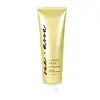What's inside
What's inside
 Key Ingredients
Key Ingredients

 Benefits
Benefits

 Concerns
Concerns

 Ingredients Side-by-side
Ingredients Side-by-side

Water
Skin ConditioningSodium C14-16 Olefin Sulfonate
CleansingSodium Chloride
MaskingCocamidopropyl Betaine
CleansingPumice
AbrasiveAnanas Sativus Fruit Extract
Skin ConditioningMangifera Indica Fruit Extract
Skin ConditioningSodium Cocoamphoacetate
CleansingGlycerin
HumectantLauryl Glucoside
CleansingSodium Cocoyl Glutamate
CleansingSodium Lauryl Glucose Carboxylate
CleansingDecyl Glucoside
CleansingSodium Lauroyl Sarcosinate
CleansingJuglans Regia Shell Powder
AbrasiveCarbomer
Emulsion StabilisingPEG-150 Distearate
EmulsifyingPhenoxyethanol
PreservativeDehydroacetic Acid
PreservativeBenzyl Alcohol
PerfumingLimonene
PerfumingParfum
MaskingSodium Hydroxide
BufferingWater, Sodium C14-16 Olefin Sulfonate, Sodium Chloride, Cocamidopropyl Betaine, Pumice, Ananas Sativus Fruit Extract, Mangifera Indica Fruit Extract, Sodium Cocoamphoacetate, Glycerin, Lauryl Glucoside, Sodium Cocoyl Glutamate, Sodium Lauryl Glucose Carboxylate, Decyl Glucoside, Sodium Lauroyl Sarcosinate, Juglans Regia Shell Powder, Carbomer, PEG-150 Distearate, Phenoxyethanol, Dehydroacetic Acid, Benzyl Alcohol, Limonene, Parfum, Sodium Hydroxide
Water
Skin ConditioningSodium Cocoamphoacetate
CleansingLauryl Glucoside
CleansingGlycerin
HumectantButylene Glycol
HumectantPolyacrylate Crosspolymer-6
Emulsion StabilisingSodium Lauroyl Sarcosinate
CleansingSalix Alba Bark Extract
AstringentSodium Cocoyl Glutamate
CleansingSodium Lauryl Glucose Carboxylate
CleansingAlthaea Officinalis Root Extract
Skin ConditioningCaprylyl Glycol
EmollientCitrus Sinensis Peel Oil Expressed
PerfumingCoco-Glucoside
CleansingDisodium EDTA
Ethylhexylglycerin
Skin ConditioningGlyceryl Oleate
EmollientHexylene Glycol
EmulsifyingMentha Viridis Leaf Oil
AstringentMenthol
MaskingPhenoxyethanol
PreservativePhoenix Dactylifera Fruit Extract
EmollientSalicylic Acid
MaskingTetrasodium EDTA
Water, Sodium Cocoamphoacetate, Lauryl Glucoside, Glycerin, Butylene Glycol, Polyacrylate Crosspolymer-6, Sodium Lauroyl Sarcosinate, Salix Alba Bark Extract, Sodium Cocoyl Glutamate, Sodium Lauryl Glucose Carboxylate, Althaea Officinalis Root Extract, Caprylyl Glycol, Citrus Sinensis Peel Oil Expressed, Coco-Glucoside, Disodium EDTA, Ethylhexylglycerin, Glyceryl Oleate, Hexylene Glycol, Mentha Viridis Leaf Oil, Menthol, Phenoxyethanol, Phoenix Dactylifera Fruit Extract, Salicylic Acid, Tetrasodium EDTA
Ingredients Explained
These ingredients are found in both products.
Ingredients higher up in an ingredient list are typically present in a larger amount.
Glycerin is already naturally found in your skin. It helps moisturize and protect your skin.
A study from 2016 found glycerin to be more effective as a humectant than AHAs and hyaluronic acid.
As a humectant, it helps the skin stay hydrated by pulling moisture to your skin. The low molecular weight of glycerin allows it to pull moisture into the deeper layers of your skin.
Hydrated skin improves your skin barrier; Your skin barrier helps protect against irritants and bacteria.
Glycerin has also been found to have antimicrobial and antiviral properties. Due to these properties, glycerin is often used in wound and burn treatments.
In cosmetics, glycerin is usually derived from plants such as soybean or palm. However, it can also be sourced from animals, such as tallow or animal fat.
This ingredient is organic, colorless, odorless, and non-toxic.
Glycerin is the name for this ingredient in American English. British English uses Glycerol/Glycerine.
Learn more about GlycerinLauryl Glucoside sugar- and lipid-based cleansing agent. It is created from glucose and lauryl alcohol.
This ingredient is a surfactant, making it easier to rinse oil, dirt, and other pollutants away.
A British study found lauryl glucoside to cause skin sensitivity for some people. We recommend speaking with a professional if you have concerns.
Other names for this ingredient include "Lauryl Polyglucose", "Lauryl glycoside", and "D-Glucopyranoside".
Learn more about Lauryl GlucosidePhenoxyethanol is a preservative that has germicide, antimicrobial, and aromatic properties. Studies show that phenoxyethanol can prevent microbial growth. By itself, it has a scent that is similar to that of a rose.
It's often used in formulations along with Caprylyl Glycol to preserve the shelf life of products.
We don't have a description for Sodium Cocoamphoacetate yet.
Sodium Cocoyl Glutamate is a gentle cleanser and surfactant. It is the sodium salt of the Cocoyl Glutamic Acid and comes from coconut oil. As a surfactant, it helps lift dirt and oil to be washed away.
Sodium Cocoyl Glutamate also has an emolliating effect and can help leave the skin feeling soft.
Sodium Lauroyl Sarcosinate is a cleansing agent and emulsifier. It is a surfactant derived from sarcosine, and a common source is coconut oil.
As a surfactant, Sodium Lauroyl Sarcosinate helps lift dirts, oil, and other molecules to be washed away. In leave-on products, this ingredient is used as an emulsifier. Emulsifier help prevent ingredients such as oils and waters from separating.
Sodium Lauroyl Sarcosinate is also commonly found as a foaming agent in shampoo, toothpaste, and shaving foam. It is amphiphilic, meaning it loves both water and fats.
Learn more about Sodium Lauroyl SarcosinateWe don't have a description for Sodium Lauryl Glucose Carboxylate yet.
Water. It's the most common cosmetic ingredient of all. You'll usually see it at the top of ingredient lists, meaning that it makes up the largest part of the product.
So why is it so popular? Water most often acts as a solvent - this means that it helps dissolve other ingredients into the formulation.
You'll also recognize water as that liquid we all need to stay alive. If you see this, drink a glass of water. Stay hydrated!
Learn more about Water